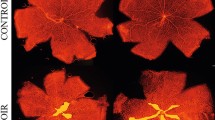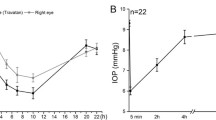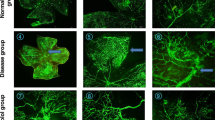Abstract
The oxygen-induced retinopathy (OIR) is a well-established rodent model of retinopathy of prematurity (ROP), which is one of the most common causes of childhood visual impairment affecting preterm babies. Pituitary adenylate cyclase-activating polypeptide (PACAP) is known to have neuroprotective effects. Several studies have revealed the presence of PACAP and its receptors in the retina and reported its protective effects in ischemic and diabetic retinopathy. In this study, we investigated whether PACAP administration can influence the vascular changes in the rat OIR model. OIR was generated by placing the animals in daily alternating 10/50 oxygen concentrations from postnatal day (PD) 0 to PD14 then returned them to room air. Meanwhile, animals received PACAP or saline intraperitoneally or intravitreally from PD1 to PD8 or on PD11, PD14, and PD17, respectively. On PD19 ± 1, the retinas were isolated and the vessels were visualized by isolectin staining. The percentage of avascular to whole retinal areas and the number of branching points were measured. Change in cytokine expression was also determined. Intravitreal treatment with PACAP remarkably reduced the extent of avascular area compared to the non- and saline-treated OIR groups. Intraperitoneal PACAP injection did not influence the vascular extent. Retinal images of room-air controls did not show vascular alterations. No changes in the number of vessel branching were observed after treatments. Alterations in cytokine profile after local PACAP injection further supported the protective role of the peptide. This is the first study to examine the effects of PACAP in ROP. Although the exact mechanism is still not revealed, the present results show that PACAP treatment can ameliorate the vascular changes in the animal model of ROP.




Similar content being viewed by others
References
Atlasz T, Babai N, Kiss P, et al. (2007) Pituitary adenylate cyclase activating polypeptide is protective in bilateral carotid occlusion-induced retinal lesion in rats. Gen Comp Endocrinol 153:108–114
Atlasz T, Szabadfi K, Kiss P, et al. (2010) Pituitary adenylate cyclase activating polypeptide in the retina: focus on the retinoprotective effects. Ann N Y Acad Sci 1200:128–139
Atlasz T, Szabadfi K, Kiss P, et al. (2011) Effects of PACAP in UV-A radiation-induced retinal degeneration models in rats. J Mol Neurosci 43:51–57
Atlasz T, Vaczy A, Werling D, et al. (2016) Neuroprotective effects of PACAP in the retina. In: Reglodi D, Tamas A (eds) Pituitary adenylate cyclase activating polypeptide—PACAP. Springer Nature, New York in press
Babai N, Atlasz T, Tamas A, et al. (2005) Degree of damage compensation by various PACAP treatments in monosodium glutamate-induced retina degeneration. Neurotox Res 8:227–233
Beharry KD, Valencia GB, Lazarro DR, Aranda JV (2016) Pharmacologic interventions for the prevention and treatment of retinopathy of prematurity. Semin Perinatol 40:189–202
Borba JC, Henze IP, Silveira MS, et al. (2005) Pituitary adenylate cyclase activating polypeptide (PACAP) can act as a determinant of the tyrosine hydroxylase phenotype of dopaminergic cells during retina development. Dev Brain Res 156:193–201
Cheng H, Ding Y, Yu R, Chen J, Wu C (2014) Neuroprotection of a novel cyclopeptide C*HSDGIC* from the cyclization of PACAP (1-5) in cellular and rodent models of retinal ganglion cell apoptosis. PLoS One 9:e108090
Clason TA, Girard BM, May V, Parsons RL (2016) Activation of MEK/ERK signaling by PACAP in guinea pig cardiac neurons. J Mol Neurosci 59:309–316
Connor KM, Krah NM, Dennison RJ, et al. (2009) Quantification of oxygen-induced retinopathy in the mouse: a model of vessel loss, vessel regrowth and pathological angiogenesis. Nat Protoc 4:1565–1573
Coorey NJ, Shen W, Chung SH, Zhu L, Gillies MC (2012) The role of glia in retinal vascular disease. Clin Exp Optom 95:266–281
Csanaky K, Doppler W, Tamas A, Kovacs K, Toth G, Reglodi D (2014) Influence of terminal differentiation and PACAP on the cytokine, chemokine and growth factor secretion of mammary epithelial cells. J Mol Neurosci 52:28–36
D'Amico AG, Maugeri G, Reitano R, et al. (2015) PACAP modulates expression of hypoxia-inducible factors in streptozotocin-induced diabetic rat retina. J Mol Neurosci 57:501–509
Danyadi B, Szabadfi K, Reglodi D, et al. (2014) PACAP application improves functional outcome of chronic retinal ischemic injury in rats—evidence from electroretinographic measurements. J Mol Neurosci 54:293–299
Denes V, Czotter N, Lakk M, Berta G, Gabriel R (2014) PAC1-expressing structures of neural retina alter their PAC1 isoform splicing during postnatal development. Cell Tissue Res 355:279–288
DeNiro M, Al-Mohanna FH, Al-Mohanna FA (2011) Inhibition of reactive gliosis prevents neovascular growth in the mouse model of oxygen-induced retinopathy. PLoS One 6:e222244
Endo K, Nakamachi T, Seki T, et al. (2011) Neuroprotective effect of PACAP against NMDA-induced retinal damage in the mouse. J Mol Neurosci 43:22–29
Fruttiger M (2007) Development of retinal vasculature. Angiogenesis 10:77–88
Fulton AB, Hansen RM, Moskowitz A, Akula JD (2009) The neurovascular retina in retinopathy of prematurity. Prog Retin Eye Res 28:452–482
Girard BM, Malley SE, Mathews MM, May V, Vizzard MA (2016) Intravesical PAC1 receptor antagonist, PACAP(6-38), reduces urinary bladder frequency and pelvic sensitivity in NGF-OE mice. J Mol Neurosci 59:290–299
Hellström A, Smith LE, Dammann O (2013) Retinopathy of prematurity. Lancet 26:1445–1457
Horvath G, Reglodi D, Brubel R, et al. (2014) Investigation of possible functions of PACAP in human trophoblast cells. J Mol Neurosci 54:320–330
Ismail JA, Poppa V, Kemper LE, et al. (2003) Immunohistologic labeling of murine endothelium. Cardiovasc Pathol 12:82–90
Kiss P, Atlasz T, Szabadfi K, et al. (2011) Comparison between PACAP- and enriched environment-induced retinal protection in MSG-treated newborn rats. Neurosci Lett 487:400–405
Lang B, Zhao L, McKie L, et al. (2010) GABAergic amacrine cells and visual function are reduced in PAC1 transgenic mice. Neuropharmacology 58:215–225
Matsumoto M, Nakamachi T, Watanabe J, et al. (2016) Pituitary adenylate cyclase-activating polypeptide (PACAP) is involved in adult mouse hippocampal neurogenesis after stroke. J Mol Neurosci 59:270–279
Nakamachi T, Matkovits A, Seki T, Shioda S (2012) Distribution and protective function of pituitary adenylate cyclase-activating polypeptide in the retina. Front Endocrinol (Lausanne) 3:145
Njaine B, Martins RA, Santiago MF, Linden R, Silveira MS (2010) Pituitary adenylyl cyclase-activating polypeptide controls the proliferation of retinal progenitor cells through downregulation of cyclin D1. Eur J Neurosci 32:311–321
Njaine B, Rocha-Martins M, Vieira-Vieira CH, et al. (2014) Pleiotropic functions of pituitary adenylyl cyclase-activating polypeptide on the retinal ontogenesis: involvement of KLF4 in the control of progenitor cell proliferation. J Mol Neurosci 54:430–442
Penn JS, Henry MM, Tolman BL (1994) Exposure to alternating hypoxia and hyperoxia causes severe proliferative retinopathy in the newborn rat. Pediatr Res 36:724–731
Racz B, Gallyas F Jr, Kiss P, et al. (2006) The neuroprotective effects of PACAP in monosodium glutamate-induced retinal lesion involves inhibition of proapoptotic signaling pathways. Regul Pept 37:20–26
Reglodi D, Renaud J, Tamas A, et al. (2015) Novel tactics for neuroprotection in Parkinson’s disease: role of antibiotics, polyphenols and neuropeptides. Prog Neurobiol. doi:10.1016/j.pneurobio.2015.10.004
Seki T, Shioda S, Ogino D, Nakai Y, Arimura A, Koide R (1997) Distribution and ultrastructural localization of a receptor for pituitary adenylate cyclase activating polypeptide and its mRNA in the rat retina. Neurosci Lett 238:127–130
Seki T, Itoh H, Nakamachi T, Shioda S (2008) Suppression of ganglion cell death by PACAP following optic nerve transection in the rat. J Mol Neurosci 36:57–60
Seki T, Itoh H, Nakamachi T, et al. (2011) Suppression of rat retinal ganglion cell death by PACAP following transient ischemia induced by high intraocular pressure. J Mol Neurosci 43:30–34
Shioda S, Nakamachi T (2015) PACAP as a neuroprotective factor in ischemic neuronal injuries. Peptides 72:202–207
Somogyvari-Vigh A, Reglodi D (2004) Pituitary adenylate cyclase activating polypeptide: a potential neuroprotective peptide. Review. Curr Pharm Des 10:2861–2889
Szabadfi K, Szabo A, Kiss P, et al. (2014) PACAP promotes neuron survival in early experimental diabetic retinopathy. Neurochem Int 64:84–91
Szabadfi K, Reglodi D, Szabo A, et al. (2016) Pituitary adenylate cyclase activating polypeptide, a potential therapeutic agent for diabetic retinopathy in rats: focus on the vertical information processing pathway. Neurotox Res 29:432–446
Szabo A, Danyadi B, Bognar E, et al. (2012) Effect of PACAP on MAP kinases, Akt and cytokine expressions in rat retinal hypoperfusion. Neurosci Lett 523:93–98
Varga B, Szabadfi K, Kiss P, et al. (2011) PACAP improves functional outcome in excitotoxic retinal lesion: an electroretinographic study. J Mol Neurosci 43:44–50
Vaudry D, Falluel-Morel A, Bourgault S, et al. (2009) Pituitary adenylate cyclase activating polypeptide and its receptors: 20 years after the discovery. Pharmacol Rev 61:283–357
Wada Y, Nakamachi T, Endo K, et al. (2013) PACAP attenuates NMDA-induced retinal damage in association with modulation of the microglia/macrophage status into an acquired deactivation subtype. J Mol Neurosci 51:493–502
Werling D, Reglodi D, Kiss P, et al. (2014) Investigation of PACAP fragments and related peptides in chronic retinal hypoperfusion. J Ophthalmol 2014:563812
Yan Y, Zhou X, Pan Z, Ma J, Waschek JA, DiCicco-Bloom E (2013) Pro- and anti-mitogenic actions of pituitary adenylate cyclase-activating polypeptide in developing cerebral cortex: potential mediation by developmental switch of PAC1 receptor mRNA isoforms. J Neurosci 33:3865–3878
Acknowledgments
This study was supported by OTKA K104984, OTKA PD109644, Arimura Foundation, Bolyai Scholarship of the Hungarian Academy of Sciences, PTE AOK Research Grant, National Brain Research Program KTIA_13_NAP-A-III/5, New National Excellence Program.
Author information
Authors and Affiliations
Corresponding author
Ethics declarations
Animal housing and care and application of experimental procedures were in accordance with institutional guidelines under approved protocols (No: BA02/2000–15024/2011, University of Pecs following the European Community Council directive).
Rights and permissions
About this article
Cite this article
Kvarik, T., Mammel, B., Reglodi, D. et al. PACAP Is Protective in a Rat Model of Retinopathy of Prematurity. J Mol Neurosci 60, 179–185 (2016). https://doi.org/10.1007/s12031-016-0797-5
Received:
Accepted:
Published:
Issue Date:
DOI: https://doi.org/10.1007/s12031-016-0797-5




